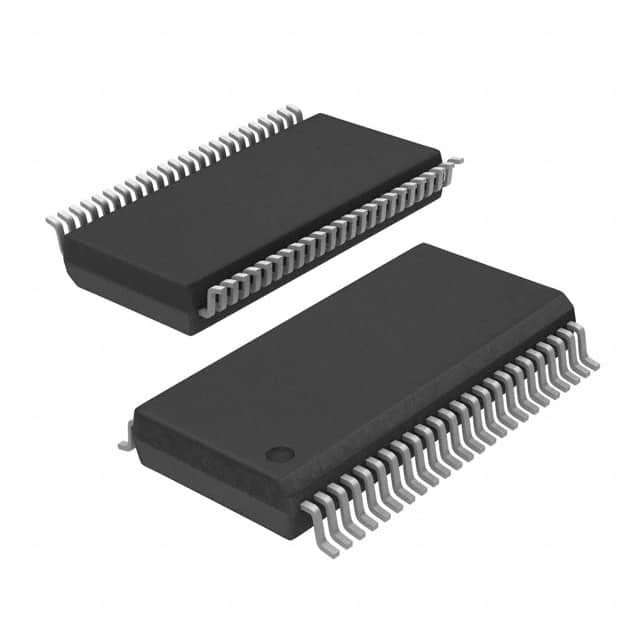74LVC16374ADGG,512
Basic Information Overview
- Category: Integrated Circuit (IC)
- Use: Flip-Flop
- Characteristics: Low-voltage CMOS device, 16-bit D-type flip-flop with 3-state outputs
- Package: TSSOP (Thin Shrink Small Outline Package)
- Essence: Digital logic component for storing and manipulating binary data
- Packaging/Quantity: Tape and Reel, 2500 units per reel
Specifications
- Supply Voltage Range: 1.65V to 5.5V
- High-Level Input Voltage: 2V to VCC + 0.5V
- Low-Level Input Voltage: -0.5V to 0.8V
- High-Level Output Voltage: VCC - 0.5V
- Low-Level Output Voltage: 0.5V
- Maximum Operating Frequency: 125 MHz
- Number of Flip-Flops: 16
- Output Type: 3-state
Detailed Pin Configuration
The 74LVC16374ADGG,512 IC has a total of 48 pins. The pin configuration is as follows:
- Pin 1: Output 1Q1
- Pin 2: Output 1Q1 Not
- Pin 3: Clock Enable (CE)
- Pin 4: Data Input (D1)
- Pin 5: Data Output (Q1)
- Pin 6: Data Output Not (Q1 Not)
- Pin 7: Ground (GND)
- Pin 8: Data Input (D2)
- Pin 9: Data Output (Q2)
- Pin 10: Data Output Not (Q2 Not)
- Pin 11: Output 1Q2
- Pin 12: Output 1Q2 Not
- Pin 13: Clock (CLK)
- Pin 14: Output 2Q1
- Pin 15: Output 2Q1 Not
- Pin 16: Data Input (D3)
- Pin 17: Data Output (Q3)
- Pin 18: Data Output Not (Q3 Not)
- Pin 19: Ground (GND)
- Pin 20: Data Input (D4)
- Pin 21: Data Output (Q4)
- Pin 22: Data Output Not (Q4 Not)
- Pin 23: Output 2Q2
- Pin 24: Output 2Q2 Not
- Pin 25: Clock Enable (CE)
- Pin 26: Output 3Q1
- Pin 27: Output 3Q1 Not
- Pin 28: Data Input (D5)
- Pin 29: Data Output (Q5)
- Pin 30: Data Output Not (Q5 Not)
- Pin 31: Ground (GND)
- Pin 32: Data Input (D6)
- Pin 33: Data Output (Q6)
- Pin 34: Data Output Not (Q6 Not)
- Pin 35: Output 3Q2
- Pin 36: Output 3Q2 Not
- Pin 37: Clock (CLK)
- Pin 38: Output 4Q1
- Pin 39: Output 4Q1 Not
- Pin 40: Data Input (D7)
- Pin 41: Data Output (Q7)
- Pin 42: Data Output Not (Q7 Not)
- Pin 43: Ground (GND)
- Pin 44: Data Input (D8)
- Pin 45: Data Output (Q8)
- Pin 46: Data Output Not (Q8 Not)
- Pin 47: Output 4Q2
- Pin 48: Output 4Q2 Not
Functional Features
- 16-bit D-type flip-flop with 3-state outputs
- High-speed operation with low power consumption
- Compatible with various logic levels due to CMOS technology
- 3-state outputs allow multiple devices to share a common bus
Advantages and Disadvantages
Advantages: - Low-voltage operation allows for compatibility with modern electronic systems - High-speed operation enables efficient data processing - 3-state outputs facilitate bus sharing in complex digital circuits
Disadvantages: - Limited number of flip-flops (16) may not be sufficient for certain applications requiring larger storage capacity - TSSOP package may require careful handling during assembly to avoid damage
Working Principles
The 74LVC16374ADGG,512 is a 16-bit D-type flip-flop that
Lista 10 Vanliga frågor och svar relaterade till tillämpningen av 74LVC16374ADGG,512 i tekniska lösningar
Sure! Here are 10 common questions and answers related to the application of 74LVC16374ADGG,512:
Q: What is the function of the 74LVC16374ADGG,512? A: The 74LVC16374ADGG,512 is a 16-bit D-type flip-flop with 3-state outputs. It can store and transfer data in digital circuits.
Q: What is the operating voltage range for the 74LVC16374ADGG,512? A: The operating voltage range for the 74LVC16374ADGG,512 is typically between 1.65V and 5.5V.
Q: How many flip-flops are there in the 74LVC16374ADGG,512? A: The 74LVC16374ADGG,512 has 16 individual flip-flops, allowing it to store 16 bits of data.
Q: Can the 74LVC16374ADGG,512 be used for bidirectional data transfer? A: Yes, the 74LVC16374ADGG,512 supports bidirectional data transfer, making it suitable for applications where data needs to be transferred in both directions.
Q: What is the maximum clock frequency supported by the 74LVC16374ADGG,512? A: The maximum clock frequency supported by the 74LVC16374ADGG,512 is typically around 100 MHz.
Q: Does the 74LVC16374ADGG,512 have any built-in protection features? A: Yes, the 74LVC16374ADGG,512 has built-in ESD protection on all inputs and outputs, ensuring reliable operation in harsh environments.
Q: Can the 74LVC16374ADGG,512 be cascaded to increase the number of flip-flops? A: Yes, multiple 74LVC16374ADGG,512 chips can be cascaded together to increase the number of flip-flops and store larger amounts of data.
Q: What is the power supply current consumption of the 74LVC16374ADGG,512? A: The power supply current consumption of the 74LVC16374ADGG,512 depends on the operating conditions but is typically in the range of a few milliamperes.
Q: Can the 74LVC16374ADGG,512 drive high-capacitance loads? A: Yes, the 74LVC16374ADGG,512 has strong output drive capability, allowing it to drive high-capacitance loads without significant degradation in performance.
Q: Are there any specific application notes or reference designs available for the 74LVC16374ADGG,512? A: Yes, the manufacturer of the 74LVC16374ADGG,512 typically provides application notes and reference designs that can help users understand and implement the chip in their technical solutions.
Please note that the answers provided here are general and may vary depending on the specific datasheet and manufacturer's documentation for the 74LVC16374ADGG,512.


